25: More Standard European Cards
A further selection of European standard patterns including various redrawings.
Here is a further selection of European standard patterns including various redrawings. The first page on this topic is page 16. The variation of design within one pattern can be remarkable. This has been my focus with regard to the standard English pattern, but it applies to most other standard patterns as well.
The form of the Paris pattern was strictly regulated in France, so that hardly any variation can be found throughout the 19th century, except in small packs and in packs destined for export. The following are mostly not from France and are quite elaborate versions of the Paris pattern. The first two are French exceptions.
A decorative version with gold in a patience pack by Grimaud, late 19th century
A slightly less conventional version by Willeb, c.1950 (sorry for the poor quality of the original slide)
Another elaborate version with some features redrawn for the Dutch market, probably made in Belgium
The earlier version of the Paris pattern, as used in the 17th century, gave rise to a lot of local variants that have become standards in their own right. Here is a selection; local idiosyncrasies, such as which way the KD and JD face, abound. Other examples are illustrated on pages 11 and 16.
Cartes marbrées, so-called because of the back design (marbled), by a Turnhout maker, possibly Brepols
The Russian version of the pattern
And the Swiss version by Müller; here the figures of the black jacks have been switched
A version by Litografia Maia, Portugal, resembling the German and Dutch versions (see page 16)
A number of European designs, most of which date to the latter part of the 19th century, have a semi-standard status in that they became established as more than a one-off non-standard design for a specific purpose. Bon Goût made in Belgium was one such: it bears a strong resemblance to the contemporary Paris-derived patterns, even though some of the figures are not in their traditional suits. For example, the KD holds a harp rather than the KS (originally representing David).
Another widely established and copied design is Dondorf's Rhineland pattern. As far as I can tell, this was an in-house design (I stand to be corrected by Dondorf collectors), but was used in several different packs of different grades and was copied by other makers.
Dondorf's original design, here from a pack with scenes from the Napoleonic Wars on the aces
A Belgian version redrawn with some changes: e.g. KS holding a sword, KD holding a sword over his shoulder rather than a sceptre
The pattern originally had the courts of each suit facing the same way, but Piatnik's version, which was available until very recently, has changed the head of the JD to three-quarters left.
Piatnik, c.1970
A good example of an invented standard is furnished by Öberg's standard Swedish pattern. From some time in the early 20th century it took over from the Scandinavian version of the Old Paris pattern, which had been used until then.
Öberg, 1943
Piatnik has also produced a version; as with the Rhineland pattern a few changes have been made, so, for example, all the kings hold orbs.
Piatnik, modern
For further examples, see the wopc website.
One of the regional French patterns has provided at least some of the figures of the Lombard or Milanese pattern, such as the bird-carrying king, the king with his sceptre over his shoulder and the profile jack.
The Milanese pattern
And finally, two more patterns which do not have French suit-signs.
The Catalan pattern by La Ducale of France
The suits of leaves and bells from the Prussian pattern by ASS; the female figure is on the two (Daus) of the suits
By Ken Lodge
United Kingdom • Member since May 14, 2012 • Contact
I'm Ken Lodge and have been collecting playing cards since I was about eighteen months old (1945). I am also a trained academic, so I can observe and analyze reasonably well. I've applied these analytical techniques over a long period of time to the study of playing cards and have managed to assemble a large amount of information about them, especially those of the standard English pattern. About Ken Lodge →

Leave a Reply
Your Name
Just nowRelated Articles

Redrawn French pattern (Héron)
Redrawn French pattern retaining traditional elements.

Standard French-suited Bavarian deck by Göbl
French-suited Bavarian deck by Andreas Benedict Göbl, late 18th c.

Paris pattern by Leclaire of Paris
Standard designs from a little-known Parisian maker.

Paris pattern variant from Lyon, c1900
Updated courts retaining elements of a standard French pack by C. Gerentes, Lyon.

English pattern from Portugal
English pattern by Litografia Maia, Porto, Portugal, c.1960.

Kaffeehaus-Pikett
Kaffeehaus-Pikett featuring the old Viennese Large Crown pattern, made by ASS.
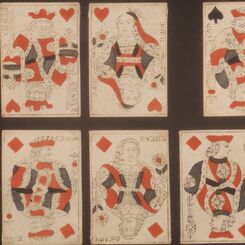
64: The descendants of the French regional patterns: 2
A continuation oF the development of the off-spring of the Paris patterns and a few examples of how ...
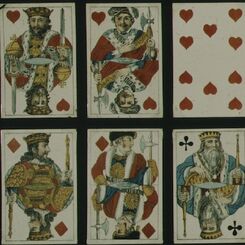
63: The descendants of the French regional patterns: 1
A great many regional patterns were exported from France and subsequently copied elsewhere. Some of ...

Trentine Pattern
Trentine Pattern

Bergamasche Pattern
Bergamasche Pattern by Modiano, 1970s.

Genovesi Pattern
Genoese pattern from Italy.

Jacob Holmblad c.1820
Standard woodblock and stencil deck produced by Jacob Holmblad with double-ended court cards in the ...

L. P. Holmblad c.1840
L. P. Holmblad's house pattern used from c.1840. The K♠ carries a harp as in the traditional French-...
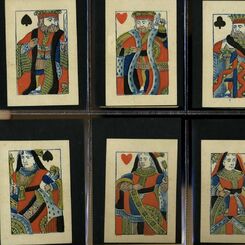
19: 19th Century Breaks with Tradition - Unusual versions of the Standard English Pattern
The centuries-long tradition of English court cards was subject to misinterpretation and in some cas...
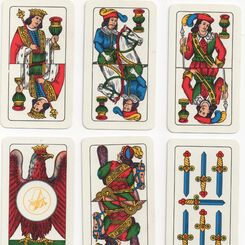
16: European Standard Playing Cards
A brief survey of the different types of standard cards to be found in Continental Europe.

La Española 2000 pattern
‘La Española 2000’ is a digitally re-drawn version of the original classic ‘La Española’ Spanish-sui...
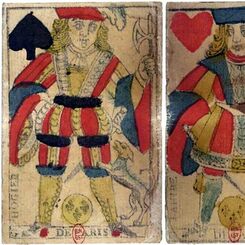
Paris Pattern
The Paris pattern was established as such around the middle of the seventeenth century (based, perha...

Swiss French Suited Playing Cards, c.1840
French-suited playing-cards in the Paris pattern appeared in Switzerland around the end of the sixte...

Müller (Diessenhofen), c.1840-50.
Playing Cards made by J. Müller, Diessenhofen, c.1840-50 with court cards coloured differently ...

Small Tuscan Pattern
Small Tuscan Pattern
Most Popular
Our top articles from the past 60 days


 Your comment here. Your comment here. Your comment here. Your comment here. Your comment here. Your comment here. Your comment here. Your comment here. Your comment here. Your comment here. Your comment here. Your comment here. Your comment here. Your comment here. Your comment here. Your comment here. Your comment here. Your comment here. Your comment here. Your comment here. Your comment here. Your comment here. Your comment here. Your comment here. Your comment here. Your comment here. Your comment here. Your comment here. Your comment here. Your comment here. Your comment here. Your comment here.
Your comment here. Your comment here. Your comment here. Your comment here. Your comment here. Your comment here. Your comment here. Your comment here. Your comment here. Your comment here. Your comment here. Your comment here. Your comment here. Your comment here. Your comment here. Your comment here. Your comment here. Your comment here. Your comment here. Your comment here. Your comment here. Your comment here. Your comment here. Your comment here. Your comment here. Your comment here. Your comment here. Your comment here. Your comment here. Your comment here. Your comment here. Your comment here.




















